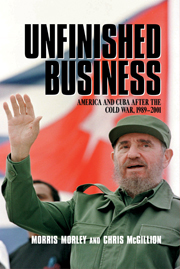Book contents
- Frontmatter
- Contents
- Acknowledgments
- Introduction
- 1 The Bush Administration and Cuba: From Cold War to Deep Freeze
- 2 Clinton and Cuba, January 1993 to February 1996: Closing the Options
- 3 Helms–Burton and the Triumph of Politics over Policy
- 4 Stirring the Waters: Clinton's Missed Opportunities
- Conclusion
- Postscript: Washington's Last Cold War
- Notes
- Index
2 - Clinton and Cuba, January 1993 to February 1996: Closing the Options
Published online by Cambridge University Press: 28 July 2009
- Frontmatter
- Contents
- Acknowledgments
- Introduction
- 1 The Bush Administration and Cuba: From Cold War to Deep Freeze
- 2 Clinton and Cuba, January 1993 to February 1996: Closing the Options
- 3 Helms–Burton and the Triumph of Politics over Policy
- 4 Stirring the Waters: Clinton's Missed Opportunities
- Conclusion
- Postscript: Washington's Last Cold War
- Notes
- Index
Summary
All of a sudden a segment of the community is starting to understand that this guy isn't as bad as they were led to believe he would be. They see that he is not going to establish relations with Castro and, in fact, that his policy is clearer and firmer than it was under Presidents Reagan and Bush.
Simon Ferro, Florida Democratic Party chairman, on Bill ClintonAS a newly elected president, Bill Clinton was well placed to regain the foreign policy initiative from Congress, to push his own ideas on issues of specific interest and to make new appointments to key bureaucratic posts through which he could seek to stamp his own mark on America's international role. An approach to Cuba more rational, if not more accommodating, than the one pursued under Reagan and Bush thus appeared at least a possibility. “The choice for President Clinton,” Peter Hakim of the Inter-American Dialogue told a congressional panel in February 1993, “is whether to pursue a fresh and more activist approach, involving an effort to mobilize an international coalition and begin bargaining with Cuba, or whether to continue a policy of passively waiting for the Cuban authorities to take the first steps, or for Fidel to pass from the scene.” The particular choices Hakim outlined were of less immediate interest than the general thrust of his testimony: Clinton had options on Cuba that were not available to his predecessor.
- Type
- Chapter
- Information
- Unfinished BusinessAmerica and Cuba after the Cold War, 1989–2001, pp. 52 - 97Publisher: Cambridge University PressPrint publication year: 2002



